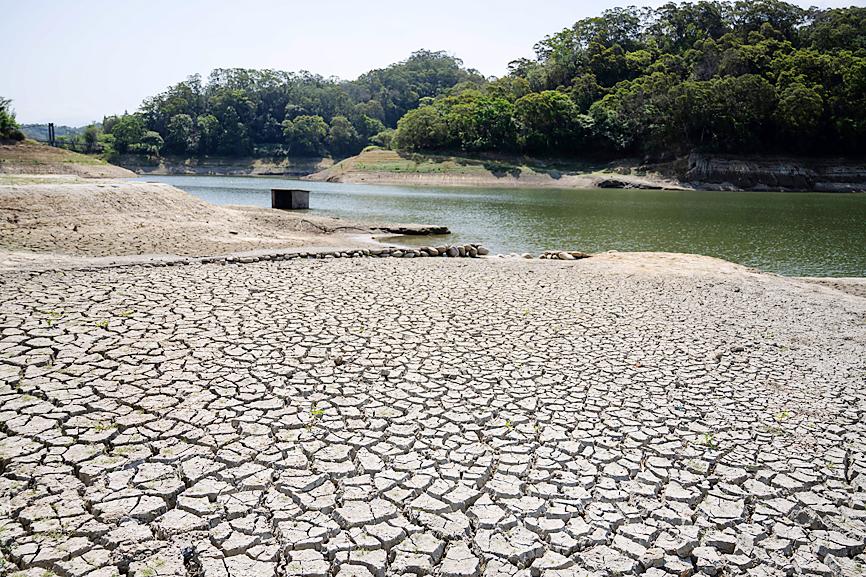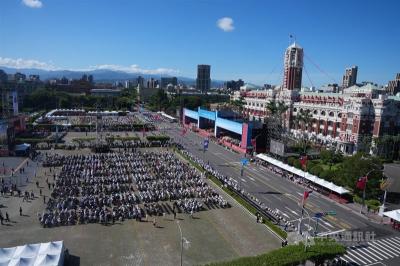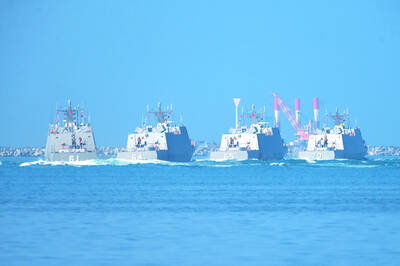A team of Academia Sinica researchers has found a correlation between the amount of rainfall and the frequency of earthquakes in Taiwan.
“The relationship between seismicity and hydrological loading cycles could provide valuable insights for improved regional hazard assessment,” the team wrote in its study, the lead author of which is Academia Sinica Institute of Earth Sciences research fellow Hsu Ya-ju (許雅儒).
A magnitude 6.4 earthquake in Kaohsiung’s Jiasian District (甲仙) on March 4, 2010, a magnitude 6.4 earthquake in Pingtung County’s Wutai Township (霧台) on Feb. 26, 2012, and a magnitude 6.6 earthquake in Kaohsiung’s Meinung District (美濃) on Feb. 6, 2016, all happened in the same season, Hsu said.

Photo: Billy H.C. Kwok, Bloomberg
Medium-level earthquakes in Taiwan occur more frequently in February and March, and less so in summer, she said.
The frequency of magnitude 2.5 to magnitude 6 earthquakes is higher in winter and early spring, and lower in the July-to-September period, Hsu said.
After identifying the seasonality of earthquakes, she analyzed the changes in water conservation and groundwater levels, Hsu added.
Changes in hydrological loading are a key factor driving the seasonal changes in seismicity, she said.
In Taiwan, there is usually more rainfall in summer due to typhoons and heat convection, increasing the hydrological loading on a thrust fault line, making it less likely to slide, she said.
When the loading decreases in winter, the fault is more likely to slide, which increases seismicity, she added.
“Taiwan is on a convergent plate boundary with abundant thrust fault earthquakes that can be used to test the influence of loading and unloading on earthquake modulation,” the study said.
While seismicity in eastern Taiwan shows the same seasonal pattern, the team’s findings are less pertinent to shallow earthquakes, at a depth of up to 18km, Hsu said.
The nation faces a prolonged dry spell this year, and the Central Weather Bureau has said seismicity so far this year is higher than previous years, corresponding with the team’s findings, she added.
The study, titled “Synchronized and asynchronous modulation of seismicity by hydrological loading: A case study in Taiwan,” was published in the journal Science Advances on Wednesday last week, and includes contributions from Canadian, Japanese and US researchers.
In related news, the bureau yesterday said rain is possible nationwide starting from today due to an approaching cloud band and a weather front, but it is unlikely to relieve the water shortage.
The cloud band is expected to move in from eastern China today and would bring rain, with brief showers possible in northern and eastern Taiwan, while precipitation is also likely in the mountainous areas in the west, particularly in the afternoon, the bureau said.
On Wednesday, a weather front is expected to approach Taiwan, with brief rain possible in northern and eastern Taiwan, it said.
The weather system is expected to strengthen and move quickly on Thursday, bringing more showers and thundershowers to the areas north of central Taiwan, it added.
However, the rain would not persist and would not be sufficient to relieve the water shortage, which has caused water to be rationed in parts of the nation, it said.
Heavier rainfall that could help to ease the dry conditions is unlikely until the upcoming plum rain season, which is expected to begin next month.

The Ministry of the Interior (MOI) is to tighten rules for candidates running for public office, requiring them to declare that they do not hold a Chinese household registration or passport, and that they possess no other foreign citizenship. The requirement was set out in a draft amendment to the Enforcement Rules of the Public Officials Election and Recall Act (公職人員選舉罷免法 ) released by the ministry on Thursday. Under the proposal, candidates would need to make the declaration when submitting their registration forms, which would be published in the official election bulletin. The move follows the removal of several elected officials who were

The Republic of China (ROC) is celebrating its 114th Double Ten National Day today, featuring military parades and a variety of performances and speeches in front of the Presidential Office in Taipei. The Taiwan Taiko Association opened the celebrations with a 100-drummer performance, including young percussionists. As per tradition, an air force Mirage 2000 fighter jet flew over the Presidential Office as a part of the performance. The Honor Guards of the ROC and its marching band also heralded in a military parade. Students from Taichung's Shin Min High School then followed with a colorful performance using floral imagery to represent Taiwan's alternate name

FOUR DESIGNATED AREAS: Notices were issued for live-fire exercises in waters south and northwest of Penghu, northeast of Keelung and west of Kaohsiung, they said The military is planning three major annual exercises across the army, navy and air force this month, with the navy’s “Hai Chiang” (海強, “Sea Strong”) drills running from today through Thursday, the Ministry of National Defense said yesterday. The Hai Chiang exercise, which is to take place in waters surrounding Taiwan, would feature P-3C Orion maritime patrol aircraft and S-70C anti-submarine helicopters, the ministry said, adding that the drills aim to bolster the nation’s offshore defensive capabilities. China has intensified military and psychological pressure against Taiwan, repeatedly sending warplanes and vessels into areas near the nation’s air defense identification zone and across

A Chinese takeover of Taiwan would severely threaten the national security of the US, Japan, the Philippines and other nations, while global economic losses could reach US$10 trillion, National Security Council Deputy Secretary-General Lin Fei-fan (林飛帆) wrote in an article published yesterday in Foreign Affairs. “The future of Taiwan is not merely a regional concern; it is a test of whether the international order can withstand the pressure of authoritarian expansionism,” Lin wrote in the article titled “Taiwan’s Plan for Peace Through Strength — How Investments in Resilience Can Deter Beijing.” Chinese President Xi Jinping’s (習近平) intent to take Taiwan by force